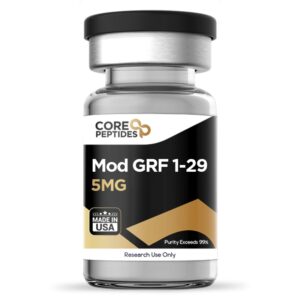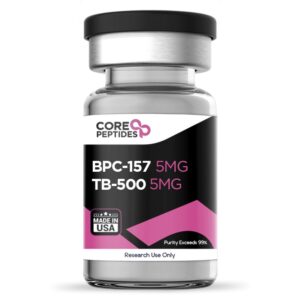Description
Matrixyl (Palmitoyl Pentapeptide-4 / Palmitoyl Pentapeptide-3)
Matrixyl is a synthetic peptide belonging to the class of matrikines—small signaling peptides that regulate cellular activity by interacting with specific receptors. It is composed of a palmitoyl-conjugated pentapeptide, which enhances its stability, lipophilicity, and penetration through the skin, protecting it from enzymatic degradation and improving its delivery to target cells. Matrixyl is primarily investigated for its potential to stimulate collagen synthesis, improve extracellular matrix (ECM) integrity, and promote skin rejuvenation.
Chemical Properties
-
Molecular Formula: C39H75N7O10
-
Molecular Weight: 802.05 g/mol
-
Other Names: Palmitoyl Pentapeptide-4, Palmitoyl Pentapeptide-3 (prior to 2006)
Mechanism of Action
Matrixyl is believed to mimic fragments of the C-terminal propeptide of type I collagen, acting as a signaling molecule that interacts with fibroblasts—the primary cells responsible for collagen synthesis in connective tissues. Fibroblasts generate structural proteins, such as collagen, elastin, fibronectin, and laminin, which form the extracellular matrix (ECM). By stimulating fibroblast activity, Matrixyl may:
-
Promote collagen synthesis and deposition in the ECM.
-
Support tissue repair and integrity.
-
Reduce signs of skin aging, including wrinkles and fine lines.
-
Influence fibroblast differentiation, reducing scar formation and abnormal fibrosis.
The peptide may exert concentration-dependent effects, with its self-assembly properties contributing to enhanced collagen production through hydrogen bonding, electrostatic interactions, hydrophobic forces, and π–π stacking interactions.
Research and Clinical Findings
-
Collagen Synthesis:
-
Studies suggest that Matrixyl stimulates fibroblasts to increase collagen and ECM protein production, supporting structural integrity and elasticity in skin tissues.
-
Self-assembling properties may enhance this effect, as aggregated peptide structures can improve signaling efficiency.
-
-
Wrinkle Reduction:
-
Clinical studies on periorbital regions demonstrated that Matrixyl reduces wrinkle depth and improves skin texture compared to placebo controls.
-
Twice-daily application over 4–8 weeks resulted in measurable improvements in skin smoothness and elasticity.
-
-
Scar and Fibrosis Modulation:
-
Matrixyl may reduce α-smooth muscle actin (α-SMA) expression, which is linked to myofibroblast differentiation and fibrotic scar formation.
-
By inhibiting excessive fibroblast-to-myofibroblast transformation, Matrixyl could minimize scarring during wound healing.
-
-
Wound Healing and Tissue Repair:
-
Animal studies suggest Matrixyl accelerates wound closure and tissue repair, with high-concentration groups showing improvements of up to 81.8% compared to untreated controls.
-
Novel formulations, including conjugates with imidazolium-based ionic liquids, further enhance skin penetration and antimicrobial activity while retaining collagen-stimulating properties.
-
-
Cosmetic and Dermatological Applications:
-
Matrixyl is widely investigated in anti-aging skincare products, including creams and serums aimed at reducing fine lines, improving elasticity, and promoting skin regeneration.
-
Conclusion
Matrixyl (Palmitoyl Pentapeptide-4) is a synthetic matrikine peptide with the potential to stimulate collagen synthesis, improve skin texture, reduce wrinkle depth, and support tissue repair. Its palmitoyl conjugation ensures enhanced skin penetration and stability, making it a valuable tool for cosmetic, dermatological, and tissue engineering research.
Note: Matrixyl is intended for research and laboratory use only. Proper handling and adherence to laboratory safety protocols are recommended.
References
-
Choi, Y. L., Park, E. J., Kim, E., Na, D. H., & Shin, Y. H. (2014). Dermal Stability and In Vitro Skin Permeation of Collagen Pentapeptides (KTTKS and palmitoyl-KTTKS). Biomolecules & Therapeutics, 22(4), 321–327. https://doi.org/10.4062/biomolther.2014.053
-
Errante, F., Ledwoń, P., Latajka, R., Rovero, P., & Papini, A. M. (2020). Cosmeceutical Peptides in the Framework of Sustainable Wellness Economy. Frontiers in Chemistry, 8, 572923. https://doi.org/10.3389/fchem.2020.572923
-
Jones, R. R., Castelletto, V., Connon, C. J., & Hamley, I. W. (2013). Collagen stimulating effect of peptide amphiphile C16-KTTKS on human fibroblasts. Molecular Pharmaceutics, 10(3), 1063–1069. https://doi.org/10.1021/mp300549d





Reviews
There are no reviews yet.